博文
Sperry 炮塔
|||
1.The sperry Retractable Ball Turret(斯佩里可伸缩球形炮塔)
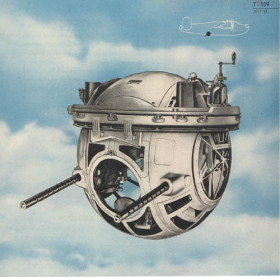
The Sperry lower Retractable Ball mounted in the belly of the PB4Y-1, is the deadly and efficient defender of the bomber’s once soft underside. It was built especially for the PB4Y-1 whose ground clearance calls for a ball turret that can be kept out of the way on takeoffs and landings, It guns sweep in a full circle and offers protection from any fighter who dips below the bomber’s level. Its sight , the Sperry K-4,computes deflections automatically even when the gunner, swinging around below the plane , is unable to tell which way he is facting. |
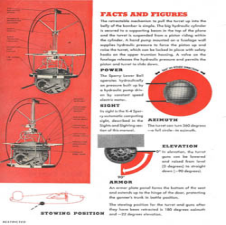
The Sperry ball turret was used on both the B-17 Flying Fortress and the B-24 Liberator as well as the Navy's PB4Y Liberator. The B-17's Sperry was not retractable. The Liberator's ground clearance was minimal and so a hoist was required to lift the turret into the airframe. The Sperry ball turret could spin 360 degrees, making it impractical to store much ammunition outside the turret. Small ammo boxes rested on the top of the turret and the remaining ammo belts were stowed in the already cramped turret by means of an elaborate feed chute system. Click on the graphic below to see this in more detail. |


Gesture in the Ball Turret
==========================================================================
2.Consolidated tail turret(合并尾炮塔)


The Consolidated tail turret was used on the B-24 & PBY Liberator bombers as well as the front turret on the B-24.

Consolidated continued to use their Sac 7 for the nose position turret, but the Emerson nose turret replaced the Sac 7 tail turret as the B-24 forward gun turret on planes manufactured at the Ford Willow Run plant in Michigan. The Emerson turret was somewhat of an improvement aerodynamically, but still had the aerodynamics of a bus. It had a wider field of fire but as with other nose turrets of the time, it did not have an air tight fit with the nose section and as a result leaked a tremendous amount of air into the fuselage. At 25,000 feet over Germany this air could be as cold as 50F degrees below zero. |
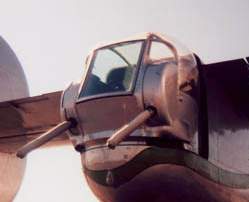
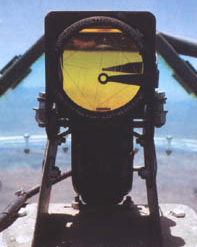
Consolidated tail turret on a B-24J Gun sight
==========================================================================
3.The Erco 250TH Turret( Erco 250TH 炮塔)
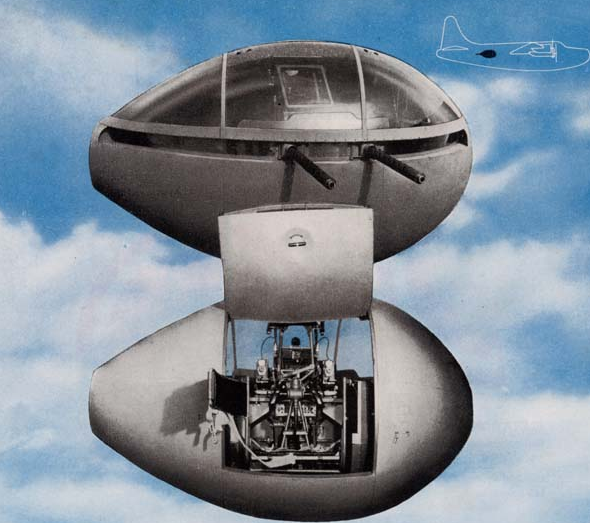
The Erco 250TH Turrets have the approximate shape of a tear drop. They are installed in the waist positions on either side of the PB4Y-2 airplane—the Erco 250TH-1 on the starboard side and the Erco 250TH-2 on the port side. With their wide cone of fire they protect the plane from beam or belly attacks, besides offering a considerable area of protection from above. In operation they are somewhat similar to a ball type turret inasmuch as the gunner moves with his guns and sight in the direction he moves his control handles. |

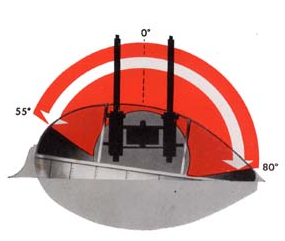
Facts and Figures POWER SIGHTS ELEVATION Both turrets can raise their guns 55° above horizontal in elevation and depress them 95° below horizontal. ARMOR The armor plate in the turret protects the gunner from fire an any direction he turns the guns. It consists of three groups: (1) 11/2" thick bullet- proof glass in front of his face, (2) 5/16" armor plate in front of his body, and (3) 5/16" armor plate under his feet. AZIMUTH In azimuth the Erco Tear Drop turret allows the guns a movement of 135°, 55° towards the bow from the beam and 80° towards the tail of the airplane from the beam. STOWING POSITION The stowing position is 0° elevation with guns pointed in the extreme aft position in azimuth (80° aft of the beam). |


A Navy gunner placing a .30 caliber ANM2 in a swivel mount.
==========================================================================
4.Martin Hydraulic Upper Deck Turret (马丁液压甲板炮塔)
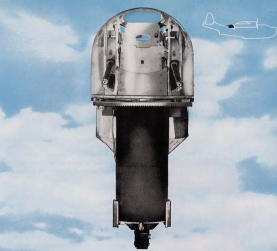
The Martin Hydraulic Upper Deck Turret is the standard Navy installation for many flying boats. It can swing its guns a full 360째 and protects the whole upper area of the plane with its deadly efficient cone of fire. There are several models, which for the most part are the same. The Martin 250CH-1 is used in a Martin "Mariner", and the Martin 250CH-3, in the Consolidated "Coronado". The Martin 250CH-2, which is almost identical with the 1 & 3, is the tail turret of the PBM-3D, and will be covered in a supplement to this section. |


Facts and Figures POWER SIGHT ELEVATION ARMOR The armor protection on the front of the turret consists of three sections to shield the gunner from enemy fire in any direction in which he points the guns: 1/2"armor plate on the sight bracket for face protection, 1/2z" armor plate for protection of the body, and 3/8" armor plate for protection of the ammunition magazines. |
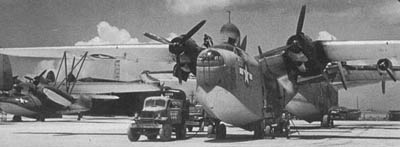
The Martin ball turret was the bow turret for the BPM-5 flying boat.
==========================================================================
5.Others(其他,如炮塔腰身、枪型等)
The waist position usually had one dedicated gunner. The radio man, when available, was the second gunner. The earlier guns used open iron sights, but as wartime technology improved, reflector sights, and then compensating reflector sights, were added. The turrets either ejected the spent shells into a holding bin, or through a chute and out of the aircraft. The spent shells from the waist guns simply dropped at the feet of the gunners creating a difficult place to work. Sometimes a shovel was used to clear a place to stand. The waist gunners had the unfortunate distinction of being in the most dangerous spot on the plane. In the photo below, left, you can see armor plates hanging beneath the rear of each gun. |
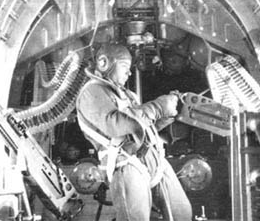

Gunners on a B-17 worked in tight quarters. B-24 gunner with Browning on early adapter.
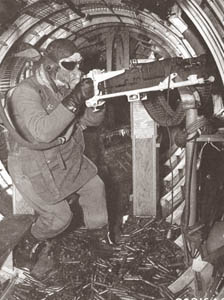

The adapter is a Mark 6. Cramped quarters in a B-24

Looking through the sights of a B-24 waist .50.
The Browning .30 caliber is a work of art. It weighs nearly 1/3 less than it's ground cousin weighs. Virtually every part has been machined to reduce its weight. With a 300 mile per hour slip stream to cool it, the barrel can be thin and light. The military version is the Browning ANM2, the Colt commercial version is the MG40. It was used in both single and twin mounts, and as a fixed wing gun up until WW2 when it was realized that the .30 caliber round was simply too light to take out modern fighter aircraft. It was replaced but the .50 caliber M2. John Browning worked with the Belgian military and developed the FN series of guns, the FN30 ground gun and the FN38 & 39 aircraft guns. During WW2 the .30 caliber Browning was primarily used in training. |

.30 caliber Browning M2 aircraft machine gun on training hard mount.


The Browning 1919-the heavy barreled .30 caliber Browning. The Browning 1919A4

The Colt Browning MG40 with slotted barrel shroud.

The Browning ANM2 fixed aircraft with a step down style barrel shroud.
声明:以上图片均来源于网络
==========================================================================
附图:

更多精彩内容 敬请期待 机械工业出版社 《机器崛起》
了解更多智能产业资讯,请关注以下微信微博公众号哦!

https://blog.sciencenet.cn/blog-951291-1009509.html
上一篇:"控制论之父"诺伯特·维纳: 关于自动化带来的一些道德与技术后果
下一篇:中国智能车驶向未来智能社会- 第二届中国智能车大会精彩实录